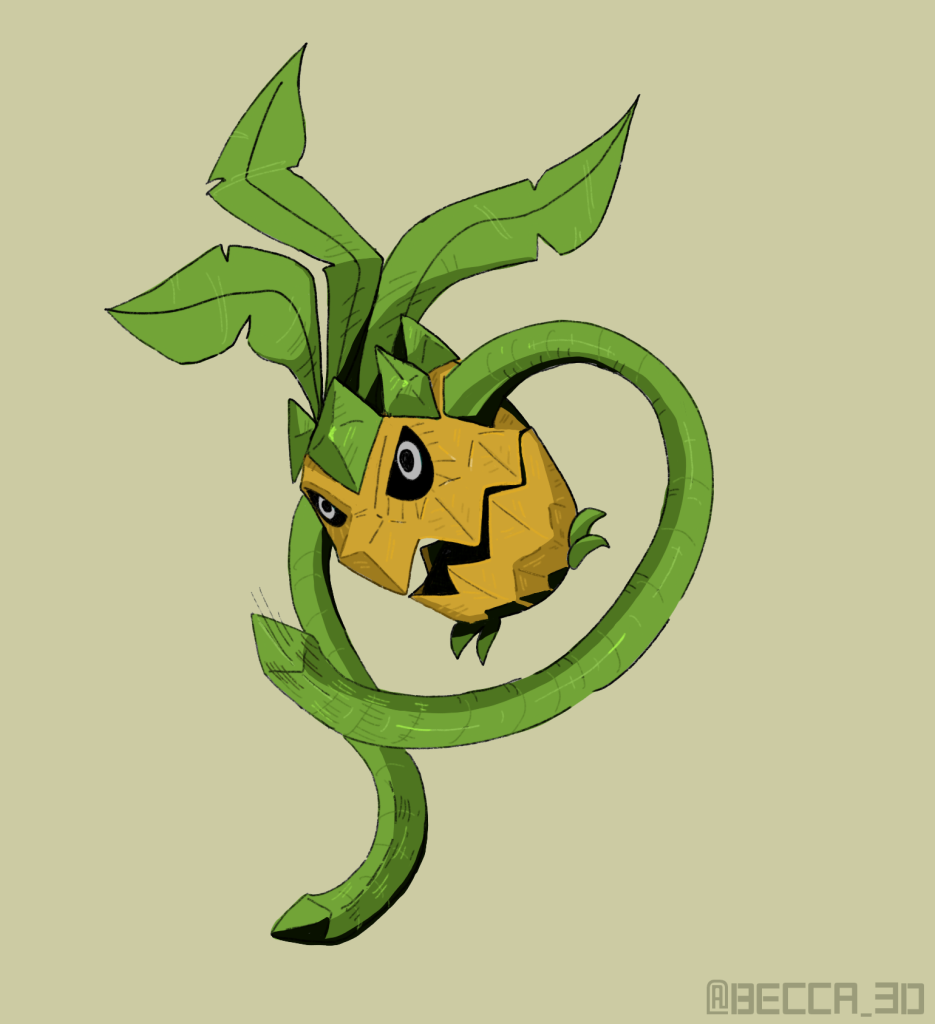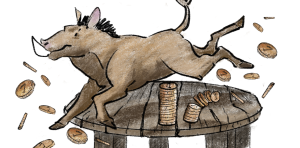Prompted by On Pokemon by Glass Ziggurat which was prompted by POKEMON ANALOGUE SANDBOX FOR A 5-YEAR OLD KID by Alone in the Labyrinth.

I’ve blogged before about pokemon style games. I released Pokemon Essence on itch.io and there are some posts from back in mid 2021 about legally distinct pokemon. Obviously old me was a fool and new me knows the best way to play a mon game. In the business, we call this personal growth.
Basic action resolution
If a mon can do something easily, then the GM narrates it how it easily does that thing.
If a mon cannot do something, then the GM narrates how it fails to do that thing.
If unsure then the GM chooses a target value from 2-6 and the player rolls a 1d6. If the player rolls equal or over the target value, then the mon is successful.
The GM chooses the target value after a discussion with the player about how good they think the mon is at the thing they are trying to do.
If the mon is really good but there is some risk then the target value can be a 2. If it is really bad but there is some chance of success then the target value can be a 6. If there is a 50-50 chance then the target number is a 4. Use 3 and 5 as target values for in-between cases.
Degrees of success action resolution
Roll as above, but also roll a d3 and look up the result on the table below.
| Initial result = Success | Initial result = Fail | |
| d3 = 1 | Success with complication | Critical Fail |
| d3 = 2 | No Change | No change |
| d3 = 3 | Critical Success | Fail with a boon |
Group world creation or GM world creation
Below I write in several instances that the table collaborates to create statements about the world. If you don’t want to do that, then don’t do that. The GM can do all that stuff in advance, but that takes prep time they might not have.

What is a ‘mon good at?
When a mon is encountered, look at the mon and write down some things that you think it would be good at. These are the mon’s aspects

Looking at Vineapple I would give it the aspects Verdant, Vine and Jaw. I would ask the players at the table if they had any other ideas. Maybe someone would suggest changing Jaw to Beak. We’d come to an agreement.
Then when Vineapple was trying to do something, use the aspects to decide whether there needs to be a roll and what the target value should be if there is a roll. If an aspect seems to powerful, discuss that at the end of the session. Edit the aspects as needed.
This system takes trust. Play with people you trust.
Some aspects, behavioural ones, are not obvious from just looking at a mon. Add those in when possible. Maybe the vineapple above gets the aspect Rage.
Below is an array of potential aspects – make them up as needed and don’t worry about their interactions or advantages – they will be reasoned out in play through the action resolution.
| Fire | Water | Air | Earth | Tail |
| Beast | Soak | Hair | Horn | Tiny |
| Sound | Shovel | Pinch | Leap | Beast |
| Whimsy | Jaw | Cute | Tusk | Light |
| Verdant | Metal | Tech | Vile | Food |
| Slime | Ghost | Cannon | Shell | Fear |
| Tall | Heavy | Mount | Artificial | Filth |
| Chaos | Clever | Dance | Claw | Fog |
Mon personalities
Whenever you encounter a new mon, the table comes up with 6 personality traits for that mon species, and the GM rolls to see which of those traits this mon has. If the mon is caught, roll a second time to generate a bonus trait. Try to make a spread of positive and negative traits, and try to use traits that are active not passive.

Ballamb’s aspects: Air, Pop, Toy
Ballamb’s traits: Jovial, Sneaky, Loud, Silly, Carefree, Trickster
Use this webpage for a big list of personality traits if you need inspiration.
Acquiring mons and their Advancement
Mons can be caught/acquired/catalogued/allied only with their permission – otherwise they can resist the acquisition mechanism. When a mon is encountered a personality trait is generated – this trait must be satisfied in some way before the mon can be acquired.
Some of those traits can be appealed by fighting the monster, but not all of them.
The players can collectively decide if the trait has been satisfied sufficiently to allow for acquisiton.
Mons cannot advance/evolve/digivolve/morph until both personality traits have been simultaneously satisfied.
Battling Mons and other vs. rolls
When battling/racing/in-a-dance-off mons’ controllers (player or GM) declare their actions and the intent of those actions simultaneously. Those actions can be judged independently using the normal resolution mechanism, unless they are directly opposed, or would be resisted by the opponent.
For an opposed roll, decide which mon, if any, has the advantage.
If neither has an advantage, roll 2d6 with a result of 7 resulting in a draw, results of 2-6 resulting in a success for mon A and results of 8-12 resulting in success for mon B. The further away from 7, the greater the success.
If mon A has a small advantage, move the middle result to 8, with results 2-7 now giving a success to mon A.
If mon A has a moderate advantage, use 9 as a middle result, and for a large advantage, use 10 as the middle result.
If mon B has the advantage, reverse the middle result, so a small advantage for mon B would have a middle result of 6.
Try to make the results of mon attacks really grounded in the reality of the world, with tangible and specific effects.
If you need a more concrete mechanism for damage, use the one below.
Most mons can endure about 3 hits, though legendary/mythical/dynamaxed/evolved mons can endure 4 or 5 and pathetic/baby/lesser mons can endure 2 hits. For most results on the opposed role, a mon takes 1 hit, but if the difference between the result and the middle number is greater than 4, then it takes 2 hits. For non-opposed battle actions, use the degrees of success rules with a critical success resulting in 2 hits taken by the target.
When a mon is has taken all the hits it can, it is out of the fight.
Encounter system
Roll a d6, with results 1, 2, 3 leading to a common mon, 4, 5 leading to an uncommon mon and 6 leading to a rare mon. Roll another d6 with low results meaning that there is merely evidence of the mon and high results meaning that the mon’s location is obvious.
So for each area you need at least 1 common, 1 uncommon and 1 rare mon.

The Pokemon RPG sphere is evolving!
LikeLike